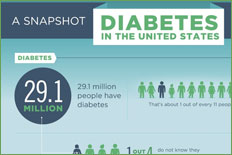Health Centers > Diabetes Center > Hypoglycemia of Infancy and Childhood
Hypoglycemia of Infancy and Childhood
As in the newborn period, hypoglycemia in infancy and childhood is caused by either decreased rates of glucose production or increased use. Decreased glucose production can be caused by increased insulin secretion, as in hyperinsulinemia with persistent hyperinsulinemic hypoglycemia of infancy, islet cell dysplasia, or adenoma.
Hypoglycemia of Infancy and Childhood
Normal Glucose Homeostasis
Glucose Requirements of Infants and Children
Hepatic Glycogenolysis and Gluconeogenesis
Hypoglycemic Syndromes
L Introduction
L Neonatal Hypoglycemia
Hypoglycemia of Infancy and Childhood
Diagnostic Evaluation of Hypoglycemia
Other causes of hypoglycemia not discussed herein include accidental or intentional, as in Munchausen syndrome by proxy, administration of oral hypoglycemic agents or insulin. Ingestion of salicylates or ethyl alcohol also causes hypoglycemia. Hepatic enzyme deficiencies, including disorders of glycogen metabolism, fructose-1,6-bisphosphatase deficiency, galactosemia, and hereditary fructose metabolism, also cause severe hypoglycemia. Hepatic failure can be complicated by hypoglycemia. Endocrine disorders, especially adrenal insufficiency or panhypopituitarism, can manifest as severe hypoglycemia.
PERSISTENT HYPERINSULINEMIC HYPOGLYCEMIA OF INFANCY
This disorder most commonly appears during the first year of life. Early recognition and management of persistent hyperinsulinemic hypoglycemia of infancy (PHHI) are of utmost importance to avoid or minimize permanent neurologic damage. A sigmoid relationship normally exits between plasma level of glucose and insulin concentration.
Only small amounts of insulin are secreted when the plasma level of glucose falls to less than 3.3 mmol/L (60 mg·dL-1). Among children with β-cell dysplasia, this relation is disturbed or disrupted. Although insulin increases the transport and metabolic clearance of glucose, the primary effect of insulin on glucose metabolism is a decrease in hepatic glucose production. The incidence of PHHI is approximately 1:50,000 in northern Europe.
Hypoglycemia
Introduction
Physiology
Pathophysiology
L Clinical Manifestations
Causes
Clinical and Laboratory Diagnosis
Treatment
L Fasting Hypoglycemia
When to Refer
Bibliography
It is much higher in countries with a high prevalence of consanguinity (1:2675 in Saudi Arabia). The following four gene defects on chromosome 11 have been identified: (1) sulfonylurea receptor defects (SUR1); (2) defects on the inward rectifying potassium channel KIR6.2 gene; (3) regulatory mutations on the glutamate dehydrogenase gene, and (4) an activating glucokinase mutation. At least 13 different mutations of the sulfonylurea receptor gene on chromosome 11p15 have been described, but only a few patients have been found to have lesions in the KIR6.2 gene.
The SUR1 and KIR6.2 mutations result in absence of KATP activity in the β cells, which leads to closure of the potassium channel, depolarization of the cell membrane, influx of calcium ions, and increased insulin release. A form of congenital hyperinsulinemia characterized by hypoglycemia and hyperammonemia is caused by defects on the glutamate dehydrogenase gene.
The Hypoglycemic States
Spontaneous hypoglycemia in adults is of two principal types: fasting and postprandial. Symptoms begin ...
Glucokinase controls glucose metabolism in the β cells and is responsible for glucose-mediated regulation of insulin secretion. Loss-of-function mutation of this gene is associated with maturity-onset diabetes of the young. However, the mutation Val455Met in the glucokinase gene causes autosomal-dominant familial hyperinsulinism by lowering the Km for glucose 65%. The long-term effects of this mutation are not clear, but the oldest affected patient had diabetes later in life. The Val203Ala and Val455Met mutations cause disease among both heterozygotes and homozygotes. The disease in homozygotes is more severe and difficult to manage. Among heterozygotes the disease is milder, manifests later, and responds well to pharmacologic treatment.
THE HYPOGLYCEMIC STATES
Introduction
Differential Diagnosis
Hypoglycemia due to Pancreatic B cell tumors
L Introduction
L General Considerations
L Clinical Findings
L Treatment
L Prognosis
Persistent Islet Hyperplasia
Hypoglycemia Due to Extrapancreatic Tumors
Postprandial Hypoglycemia (Reactive Hypoglycemia)
L Postgastrectomy Alimentary Hypoglycemia
L Functional Alimentary Hypoglycemia
L Late Hypoglycemia (Occult Diabetes)
Alcohol-Related Hypoglycemia
L Fasting Hypoglycemia after Ethanol
L Postethanol Reactive Hypoglycemia
Factitious Hypoglycemia
Immunopathologic Hypoglycemia
Drug-Induced Hypoglycemia
Both focal and diffuse histopathologic abnormalities are associated with PHHI. Focal abnormalities occur among 30 to 50% of patients treated surgically. Some patients with the focal form have lost the maternal allele of chromosome 11p15 in the hyperplastic lesion. Some of these patients have a mutant SUR1 gene inherited from the father. Loss of the maternal allele caused hemizygosity or homozygosity of the paternal defective allele of the SUR1 gene and caused a recessive endocrine disorder associated with focal β-cell hyperplasia and hyperinsulinemia.
The primary aim of therapy for childhood hyperinsulinemic hypoglycemia is to prevent neurologic symptoms and sequelae, including seizures and mental retardation. The therapeutic approaches to PHHI are directed at decreasing insulin secretion pharmacologically or surgically. It is important to differentiate the focal and diffuse forms as early as possible, because the focal form responds well to partial pancreatectomy.
Medical management of hyperinsulinemia includes diazoxide, which blocks the sulfonylurea receptors on the β cells. The result is opening of the potassium channels and decreased insulin release. Doses of 5 to 20 mg/kg/d are administered. Side effects are hypertrichosis, advanced bone age, mild hyperuricemia, decreased IgG concentration and neutrophil counts, and sodium and water retention. Water retention can be reduced with concomitant administration of hydrochlorothiazides, which further reduce insulin secretion. Life-threatening complications such as ketoacidosis, congestive heart failure, and nonketotic hyperosmolar coma can be avoided with appropriate monitoring of plasma level of glucose, urinary levels of ketones, and fluid balance. If treatment with diazoxide is not successful, somatostatin analogs and Ca2+-channel blockers can be tried. However, long-term follow-up studies of the potential side effects of these drugs are not available. Glucagon may be useful during the initial stabilization period and before surgery. Insulin-like growth factor I has been reported to inhibit insulin secretion among persons with hyperinsulinemia.
When hyperinsulinemia is proved and medical therapy does not control hypoglycemia, surgical exploration is indicated for any child past the first weeks of life. Selective resection of focal anomalies often is curative. The diffuse form necessitates subtotal pancreatectomy, in which 95% of the pancreas is removed while leaving the spleen intact. The variable results of surgery reflect differences in the pathophysiological mechanism and the extent of pancreatectomy. After subtotal pancreatectomy, exogenous insulin may be needed for several months to control hyperglycemia. Conversely, recurrence of hypoglycemia within days of surgery portends future problems in the establishment of reasonable control of glucose homeostasis. Sufficient exocrine pancreas usually is preserved to avoid fat malabsorption. Careful follow-up care of each patient is needed to evaluate the long-term effects of subtotal pancreatectomy on endocrine and exocrine pancreatic function. When surgical results are poor, medical management must be continued.
ISLET CELL DYSPLASIA OR ADENOMA
These rare disorders can manifest as hypoglycemia. In the care of older children and adolescents, other endocrine abnormalities (hyperparathyroidism, hypergastrinemia, and pituitary tumors) must be sought in the patient and his or her family to exclude MEN 1. The plasma insulin response to fasting or insulin secretagogues does not differentiate these various disorders. Because adenomas are generally less than 1 cm in diameter and are rare among infants and young children, celiac arteriography, MR imaging, and CT are of little diagnostic value. Percutaneous and intraoperative ultrasonography are highly sensitive techniques in identifying some insulin-producing tumors of the pancreas.


